Earlier this month, myself and several other content creators and members of the press got to go hands-on with BioWare’s long-anticipated RPG Dragon Age: The Veilguard. I came away from my seven hours with it really impressed with what feels like the most cohesive game BioWare has put together since probably 2012’s Mass Effect 3. And part of that time was spent exploring the capabilities of the game’s character creator, with which we had full freedom.
Order Dragon Age: The Veilguard:Amazon | Best Buy | GameStop
In recent years, in-depth conversations about character creators have become more common—particularly conversations about which players can see themselves reflected in the options such a creator offers, and which players can’t. During a developer Q&A after the demo, the BioWare folks were upfront about the fact that inclusivity was a prime concern for the dev team, and spoke on how important it was for them to represent everyone. But does it seem like they met that goal? I talked with But Why Tho editor-in-chief Kate Sánchez, who covered the event for Paste Magazine, about the strides BioWare has made in The Veilguard’s character creator, and the steps the studio has yet to make in representing everyone.
(This conversation has been edited for length and clarity.)
Kenneth Shepard: Hi Kate. Thanks for taking the time to talk with me about The Veilguard’s character creator. So, first off, tell me what your experience has been with character creators, not just with Dragon Age and BioWare, but more broadly.
Kate Sánchez: Let me explain it with Mass Effect: Andromeda. When that came out, I spent two hours in the character creator. I spend a lot of time in character creators because I do try to, even if I can’t make myself, I try to make an idealized version of myself in some way. But I have to be [reflected in the creator in some way], whether it’s my hair, it’s my body, or my skin color. And so it’s kind of my favorite part of games in a way because I think it allows me to be more immersed in the story that’s happening. That being said, often hair choices are extremely awful and skin color is extremely awful, especially for a large shade range. So I would say most of the time, you end up with, like, a lot of pinks and different undertones for paler skin or fairer skin. And then when you get to the more melanated side of the spectrum, you end up jumping completely from a slight tan to a darker skin tone. And there’s such a spectrum that goes in between that and a lot of that was developers being like, “hey, we need to have, you know, Black and brown skin,” but then like it’s only three options. So yeah, that’s kind of usually where I’ve been focused because skin tone has, I think, been one of the harder things to nail down when it comes to character creators.
Shepard: I tend to handle character creators in a similar way. I always try to make some version of myself in whatever way I can. I’ve even written about it over at Kotaku about how I’m basically leaving time capsules of who I was within every video game that I play.
Sánchez: Yes!
Shepard: And so I recognize, as a white dude who doesn’t even have to worry about my hair because that’s always a non-factor and who is usually not lacking in terms of options for beards, that I am very privileged in that way where I’ve watched a lot of people, people of color especially, have to constantly be advocating for themselves in terms of finding the options that they need. To some degree, we are seeing a lot of improvement. But while there have been a lot of steps forward in some aspects, other aspects still feel neglected. So I did want to ask, what kind of characters did you end up making at this preview event?
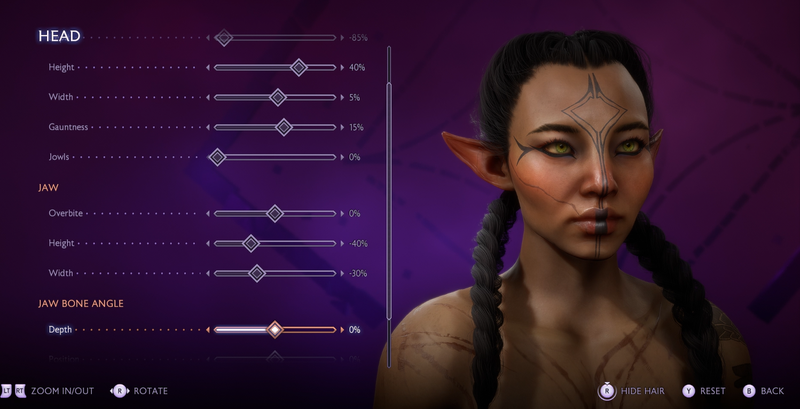
Sánchez: Oh, gosh, I made an elf. She’s beautiful. I love her. Brown skin, chunky cheeks. I’m Indigenous Mexican and I have a few defining factors for me and that is really long hair, really high cheekbones, and a very specific nose. And so for me, I think I spent the most time working in the facial creator here. I was able to find a nice skin tone. I really liked that the way that they approached it was the same way that makeup companies approach it. So you have CNW, or Cool, Neutral, Warm. That’s actually how foundations a lot of the time break down one color range, which I thought was really cool and wrote about in my preview. I made an elf as tall as she could be, [moved] sliders for hips, glutes, and breasts as much as they could be, which wasn’t that much. I made her mostly muscular. She’s an athlete, right? Like she was gonna be this sword-and-board hero. So I thought, “well, she has to hold the board.”
I gave her boxer braids. It’s kind of like French braiding but they’re just usually really long. They’re called boxer braids because they’re a dual-braid style that a lot of boxers wear to keep their hair out of their face. If I knew how to French braid my own hair, it would be what I wear consistently. And there’s this thing that happens when you do it, when you have really long hair, and even when you do regular braids, something that’s been taught to me from my community, is you kind of clip it at the bottom so that it doesn’t just kind of run all freely and it keeps everything really tight. And so usually you will braid the top part, you’ll put a small hair tie to keep it at the base and then you’ll continue braiding from that piece. And it was that small little feature that I saw on that hairstyle that made me really excited because that’s how I wear my hair when I can.
Shepard: There’s been a lot of talk about the hair tech specifically. I think they pulled from one of the EA Sports games in terms of that tech and trying to capture a large variety of hairstyles, which was really interesting to see and it feels like it’s paid off. When you had all of that setup, how did the hair behave in terms of the physics?
Sánchez: Oh, it was beautiful. It looked beautiful. They actually used EA Sports FC’s tech. And you’re dealing with characters, especially on the FIFA side of things or the soccer side of things that have a wide variety of hairstyles and there’s no way to hide it in a helmet. So they’ve had to invest more and more in these character likenesses over time. That’s something that I’ve always wondered about: why certain EA properties didn’t have great skin or hair color choices or hair physics choices? Because their sports games have always really excelled in likenesses, and I think that’s been great. I thought the hair worked really beautifully, especially seeing the two braids in motion.
I think hair means a lot culturally for a lot of people. For me, having my hair long really connects me to the women that I saw growing up, and just kind of like my indigeneity that I’ve had to work really hard, my family has had to work really hard to kind of come back to and reclaim. So having long hair in a game is something you [generally] don’t get to do. As much as I would love to have long hair in a game. I would say most games, just because of technology restrictions, don’t have long hair options. They stop at a bob or a bun, ponytail, maybe a braid here or there, but nothing is really long and flowing. And so getting to play with that in the game, it looks really natural, it looks really good.
I think for me, I didn’t do the really long, mid-back-length hair even though it was pretty because I’m like, “no man, if my girl is fighting, she needs to have it in braids or put up in some way.” And so I thought they approached that really well and there wasn’t once where I didn’t think it looked fantastic. And particularly for the braids that my character was wearing as she would move, you could see where it was held in place at the base of her neck and you could see the back, two braids kind of moving with her and moving in the different environments which I thought was really well done, and kind of a realistic element that, like, my hair does that movement. If I’m working out while my hair is in braids, it does that.
Shepard: So the funny thing about this whole entire demo process was I was like 30 minutes behind everybody because I got very meticulous about trying to recreate myself.
Sánchez: I was too!
Shepard: We are the same brain. Same brain cell that we’re passing back and forth. When I create a character, I pull up pictures of myself just to get every single detail as close as I possibly can. And one thing I really appreciated was the way that they allowed you to mold body proportions. I enjoyed it a lot because it felt like it never really got to the point of absolute caricature levels of distortion. I’m 5’3” and I don’t usually get to make a short man in games unless I am playing like, say, an elf, who tends to have a very slender body, or a dwarf who is way shorter than I need to be.
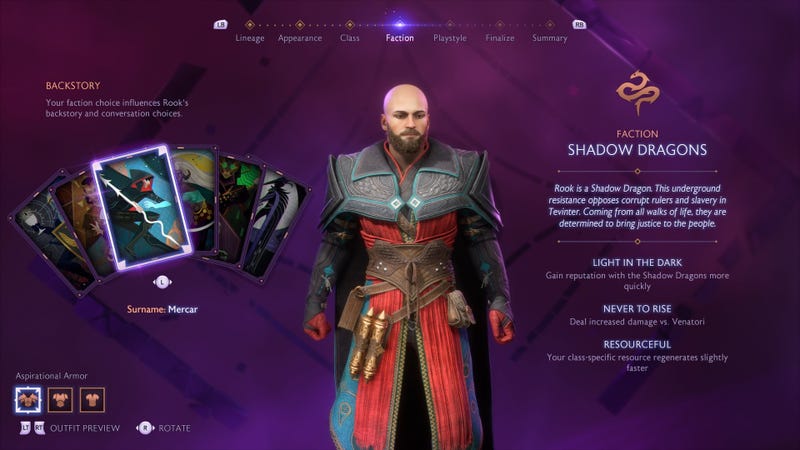
So I’ve been able to make a human character that was about my height [in The Veilguard]. But also, as a short man, my proportions are sometimes off in terms of how video games build characters. Hell, I have trouble finding clothes that fit me half the time. So, in The Veilguard I was able to have the same kind of broad shoulders and chest that I have relative to my shorter torso and that was something that Dragon Age doesn’t typically let me do. It’s something BioWare has never really let me do in any of its games because characters have kind of been locked into the same sort of silhouette no matter what you do with the character creator. So it was nice for me to be able to get that next step towards looking like myself in a game. But you were telling me about how, while they’ve clearly made some steps in this, there are some things that they could still work on.
Sánchez: So for me, it was actually really frustrating. There’s this weird thing where when you allow people full range to do whatever the hell they want in a character creator, they will make the weirdest-looking gremlins in existence. I remember when it happened in Ark. And I agree with you, there was a large focus on making realistic characters and realistic body types [in The Veilguard], but I think that one of the things that was extremely frustrating to me is that hips, breasts, glutes, [even] when you slid that slider all the way down [the changes to your character’s body weren’t that] noticeable.
Salma Hayek’s body exists. Sofia Vergara’s body exists. Megan Thee Stallion exists. When we looked at [BioWare’s Q&A] where they talked about representing everybody’s bodies, it was all white people. There is a Eurocentric idea of what bodies are. And so usually when people talk about going against beauty standards, they are often talking about including people with a larger build, which is what this game does. However, most people designing this are white people. Nobody actually thinks about what has happened historically for women of color, particularly Black and brown women who do live in bodies that have consistently been oppressed because of the way they look and have been fetishized because of the way they look. And instead of actually allowing players [to create characters with those types of bodies] or even acknowledging that Black and brown women would play this game and deserve the ability to make their bodies in this game, [it’s almost as if] those can’t exist because everybody has co-opted [that body type] and made it automatically be sexualized. When no, big breasts aren’t necessarily sexualized.
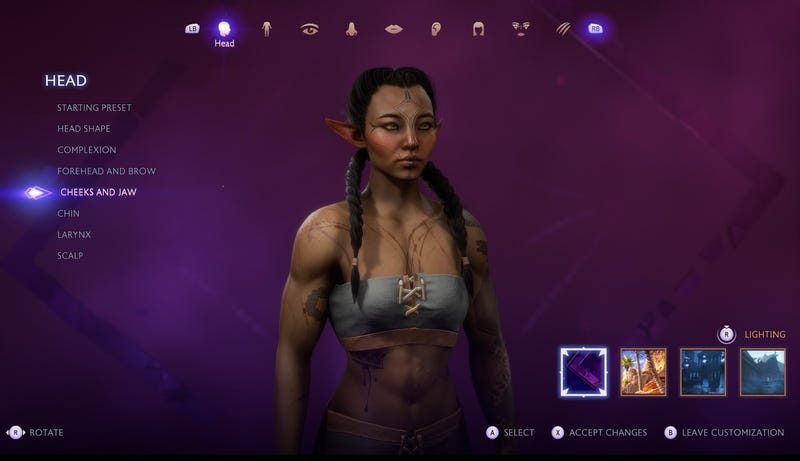
I have triple Ds. I am a 38 triple D. That is my breast size. I didn’t alter my body. I didn’t choose to have them. That is what I have. And there are a lot of women who have that breast size. And so it is frustrating when I am being told that my body type, my body can’t exist in these games because they’re aiming for something “realistic.” And I do think the Dragon Age team is very well-meaning in wanting everybody to feel represented, but all of the Black and brown women in my life, my friends, none of our bodies can be represented in there. And a lot of it is because they have just kind of ceded the idea. It’s an overcorrection for the really crappy people saying that things need to be sexy without recognizing that I can’t control if somebody sexualizes a picture of me and my breasts, right? And if we keep those options out, they are very effectively not recognizing that these bodies are something that we have to live in, and that we are consistently told aren’t okay.
I’m not a Black woman, but from what I’ve seen with the Black women in my life, there are white women who will replicate the way that their bodies look and be treated very differently. They will be admired, they will be loved. And at the same time, the Black women in my life who have those bodies naturally are maligned. They’re oversexualized, they’re hurt, they’re oppressed. They are seen as less desirable. And then, people say it all the time, cultures and white people love the way that Black people look, but they don’t actually love Black people. And I think if you also look at the history of cinema for Latinas, it’s very similar. As much as Sofia Vergara’s accent held her back, it was also her body that did too. And she’s talked a lot about that. Salma Hayek has talked a lot about the sexual harassment that she has faced on set because she was seen to only be one way and had her mind completely devalued.
And so I actually got really frustrated and kind of angry with the Dragon Age character creator because I’m sorry, like you should be allowed to have big breasts in a game. You should be able to have wide hips in a game. Because if you just throw that all out to not give bad actors the ability to do something, you’re effectively just erasing us.
Shepard: It’s frustrating because a lot of steps have clearly been made [in The Veilguard and other games] in terms of the hair tech to better represent Black hair. Also, as you said, they’ve done the work in terms of how you affect your skin shaders to reach different pigmentations. But then there’s always these other details that show we’re not quite there yet. And to your point, part of it certainly affects the body proportions that you can have, but it also just felt, bare minimum, like the sliders aren’t really doing a whole lot anyway. Like I feel like I have to put the glute sliders to the very end just to make it look like my character has an ass to begin with.
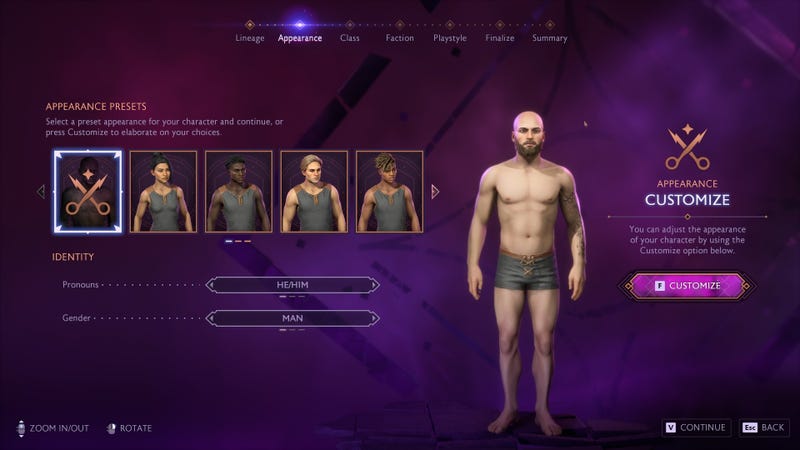
Something else that also frustrated me—part of it may factor into perceived beauty standards, but also I think part of it might just be a tech thing—is there weren’t body hair sliders either. I’m making this character who is supposed to be me and that is a bare-chested man. And I’m just like, “That is not how I look. That’s not how most people look.” There are little things that still aren’t really getting to where I think they are aspiring to. Because like you said, I think they are very well-meaning. I think they are trying their best to take steps to represent a wide swath of people. But those next steps forward still need to happen before I think they’re really achieving that.
Sánchez: No, I agree. I think the thing is, and this is gonna maybe sound meaner than I mean it to, diverse hair texture and diverse skin tones have always been a problem in gaming, right? Like that has been the thing, [the lack of options here] is always pointed out, and for good reason. I do think that there is a difference between approaching things with the mindset of being inclusive in the sense of including Black and brown people, with that at the front of your mind, and being inclusive where there is no real intent other than I’m going to fix the issues that people have pointed out, and that kind of keeps you from going all of the way. And it’s not wrong, like everybody is on their journey of understanding what including a wider audience feels like. It is literally a journey. You don’t know what you don’t know. I actually think it was really funny at Summer Game Fest when [BioWare] debuted the hair tech and they were playing the demo with a Black character, I was the only person of color in that entire group. It was a room full of white dudes—most of which didn’t have hair.
Shepard: Represent!
Sánchez: It was funny to me in a way because I knew what they wanted to do. But it also made me understand that when these reviews get written up and when people talk about [the character creator], [BioWare is] kind of in this already sucky loop of feedback because [the people who typically get invited to these events—most often white men—are unlikely to have the necessary perspective or concern to raise these kinds of valid critiques]. Now, I was very happy at our event because even though there were virtually no press of color, there were a lot of creators that came that were Black and brown […] and were welcomed to be at the preview [and to give feedback about the character creator to BioWare]. But it’s weird because I know they mean well, I just feel like if there was just somebody in that room speaking about their own body in that way, we would see something different happening.
And I don’t disagree about character models. And it is really weird to have no [body] hair options, especially when you’re in a game that has dwarves and stuff, like, come on. And obviously, I don’t know what those conversations are. I’m not in the room making it either, but I also do wonder if the reason [the body types are so limited] was because they were working with the sports teams primarily for their tenure and really did only focus on male character models with the exception of, you know, introducing the women’s team, but on the women’s team you’re also only dealing with, with like pure athletes. The soccer player body type is a very specific kind of body type, which I actually would say is represented when you go the full muscular route.
Yeah, I don’t know, I feel bad but also I’m tired, man, I’m tired of people vilifying boobs. Like, I’m sorry. I would get rid of my triple Ds if I could because it hurts my back. But they’re here to stay. So I’d like to see it in a game.
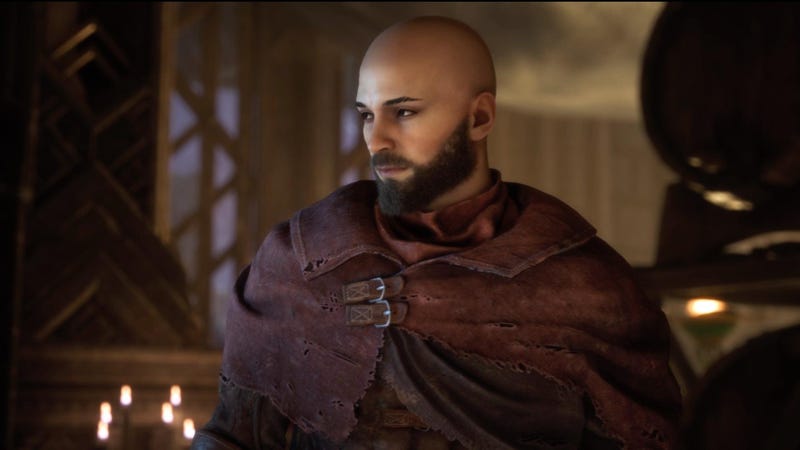
Shepard: One thing I do want to point out though as a positive for me was that they finally included non-binary pronouns, and they have it where that’s not at all tied to your body type. We often cite BioWare and their character creators, relationships, romances, and such as being at the forefront of inclusive design in the AAA space. But it’s been so long since we’ve had a BioWare RPG that they haven’t ever really had that before. That’s become much more common in the years since Inquisition, in the years since Andromeda, even. And so it was nice to see that studio finally getting to cook with those tools and design around those.
Sánchez: 100 percent.
Shepard: And I’m interested to see how that plays out because I know that there have been some quotes from, I think, [game director] Corinne Busche said at some point in the game, they have not explained how, there’s going to be a chance to talk about trans identity. If that is who your character is, you could even have top surgery scars as well. It’s all about the intersection of these things. We’ve been very critical here, but I do want to express that some steps are being made and hopefully they can take this feedback into account in the future in whatever the next game is—Mass Effect 5, I guess, and they can actually implement some more of this. They talk a lot about how their goal is to make people feel like they can see themselves in their Rook. And, you know, BioWare, you’ve made some good efforts and good half steps, but there’s still some feedback to be taken from this. And like you said, I hope that there are gonna be voices in the room raising these issues in the future. And also just in the critical spaces that can advocate for these things because I do think, based on everything they said, that they would be open to that feedback.
Sánchez: I do too. And I think that when they were creating the ability to make a trans character in the game, there was that intersection there. There was a very clear intent to do that. And I think that that’s beautiful and it’s what we need more of. There are multiple intersections and I think that what keeps frustrating me is that I feel like they were like, “okay, cool. Our intersection [for The Veilguard] was hair and skin color. Boom. Done.” I would love to know what the development breakdown was on that team. I don’t want to be the Debbie Downer. I just know that race consistently gets missed in these things all of the time. It’s the intersection that people just throw away because there is no proximity to whiteness and it’s not easy to tackle. And I think that that’s why it kind of hurts a lot, because they did show intent and care for something. And I think that that’s actually what makes me feel worse about not including body types that brown and Black women have, because like it’s almost like there was intent for everything but that.
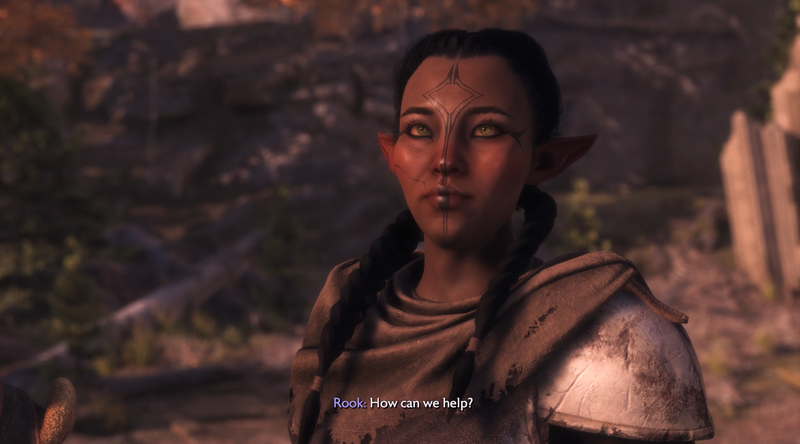
So it does feel really hard because there are already very few brown and Black women who are in games media. There are very few developers that are given the job at AAA studios. How much more do we have to do a talk like this and write about it? Because it doesn’t feel good to always poke holes and stuff. I wrote like 1000 words on the character creator for my preview. And it sucked that I couldn’t just praise all of the developments that were happening. Because god, I have never seen hair look this good in a game. I have never seen such an inclusive standpoint. Like they even have, you know, heterochromia, they have vitiligo, they have all these very clear intentional decisions. And so, as a brown woman who lives in the body that I do, it was just one of those things where it’s like, why did you miss here almost? I don’t want to sound like an asshole, or consistently be maligned as the person who brings up race. I would just like games, for once, to see us as we are. I’m excited for other groups to get that intent, but it’s just like, especially with a 10-year dev cycle, why can’t we give that to everybody? But if there’s any team that can do it, like you said, I think that it is BioWare. The one thing I took away from listening to everybody on that panel talk about the character creator is that they really cared, and I think that they just need to be shown kind of where those misses were.
Shepard: Yeah, and you know, if nothing else, maybe we won’t even have to wait until Mass Effect 5. Maybe they will hear some of this from folks who want those options and they can make these changes after the game comes out. They clearly care about the game they’re putting out and they do seem to have those ideas of inclusivity in mind. So fingers crossed that something changes moving forward.

Leave a Reply